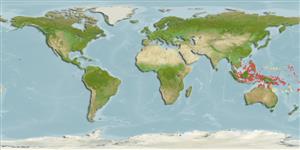>
Gobiiformes (Gobies) >
Gobiidae (Gobies) > Gobionellinae
Etymology: Redigobius: Latin,. Redere = to come back + Latin, gobius = gudgeon.
More on author: Bleeker.
Environment: milieu / climate zone / depth range / distribution range
Ecología
marino; agua dulce; salobre bentopelágico; anfidromo (Ref. 59012); rango de profundidad 0 - 5 m (Ref. 86942). Tropical; 17°N - 20°S
Asia and Oceania: Andaman Islands, Philippines, Indonesia, Micronesia (Palau) and New Guinea. One record from the Solomon Islands may possibly belong to this species. Record from New Caledonia has not been verified yet (Ref. 84480). Reported from Australia, Fiji (Ref. 7050) and Singapore (Ref. 419).
Tamaño / Peso / Age
Maturity: Lm ? range ? - ? cm
Max length : 4.5 cm SL macho / no sexado; (Ref. 7050)
Short description
Morfología | Morfometría
Espinas dorsales (total): 7; Radios blandos dorsales (total): 6-8; Espinas anales 1; Radios blandos anales: 6 - 7. Distinguished by the following characteristics: slender with compressed head and body; greatly enlarged jaws in adult males with lips distinctively broadened anteriorly and narrowed below eye; body with scale margins outlined forming reticulate pattern; dark band along mid-side of body; head with 4-6 curved oblique dark bands crossing cheek and small dark mark behind upper rear part of eye; variably sized black blotch on posterior part of first dorsal fin; second dorsal rays I,6-8; anal rays I,6-7; pectoral rays 15-18; longitudinal scales 22-25; TRB 7-8 1/2; predorsal scales 6-9 (Ref. 84480).
Adults inhabit sea and rivers (Ref. 419). Found in estuaries and lower (tidal) reaches of freshwater streams (Ref. 2847). Usually recorded from swift flowing streams, often described as cascades or cascade zone, above or below waterfalls, with solid rock, boulder and gravel substrate. A few sites consisted of mud and sand substrates and one was from a mangrove only 50 m from the shoreline. Gut content of one specimen from Palau contained insect remains and a few nematodes (Ref. 84480).
Life cycle and mating behavior
Madurez | Reproducción | Puesta | Huevos | Fecundidad | Larva
Larson, H.K., 2010. A review of the gobiid fish genus Redigobius (Teleostei: Gobionellina), with descriptions of two new species. Ichthyol. Explor. Freshwat. 21(2):123-191. (Ref. 84480)
IUCN Red List Status (Ref. 130435)
Threat to humans
Harmless
Human uses
Más información
Nombres comunesSinónimosMetabolismoDespredadoresEcotoxicologíaReproducciónMadurezPuestaAgregación para la puestaFecundidadHuevosEgg development
Age/SizeCrecimientoLength-weightLength-lengthLength-frequenciesMorfometríaMorfologíaLarvaDinámica larvariaReclutamientoAbundanciaBRUVS
ReferenciasAcuiculturaPerfil de acuiculturaRazasGenéticaElectrophoresesheritabilidadEnfermedadesProcesamientoNutrientsMass conversion
ColaboradoresImágenesStamps, Coins Misc.SonidosCiguateraVelocidadTipo de nataciónSuperficie branquialOtolitosCerebrosVisión
Herramientas
Special reports
Download XML
Fuentes de Internet
Estimates based on models
Preferred temperature (Ref.
123201): 27.4 - 29.4, mean 28.8 °C (based on 1088 cells).
Phylogenetic diversity index (Ref.
82804): PD
50 = 0.5000 [Uniqueness, from 0.5 = low to 2.0 = high].
Bayesian length-weight: a=0.00977 (0.00442 - 0.02163), b=3.05 (2.86 - 3.24), in cm total length, based on LWR estimates for this (Sub)family-body shape (Ref.
93245).
Nivel trófico (Ref.
69278): 3.3 ±0.4 se; based on size and trophs of closest relatives
Resiliencia (Ref.
120179): Alto, población duplicada en un tiempo mínimo inferior a 15 meses (Preliminary K or Fecundity.).
Fishing Vulnerability (Ref.
59153): Low vulnerability (10 of 100).
